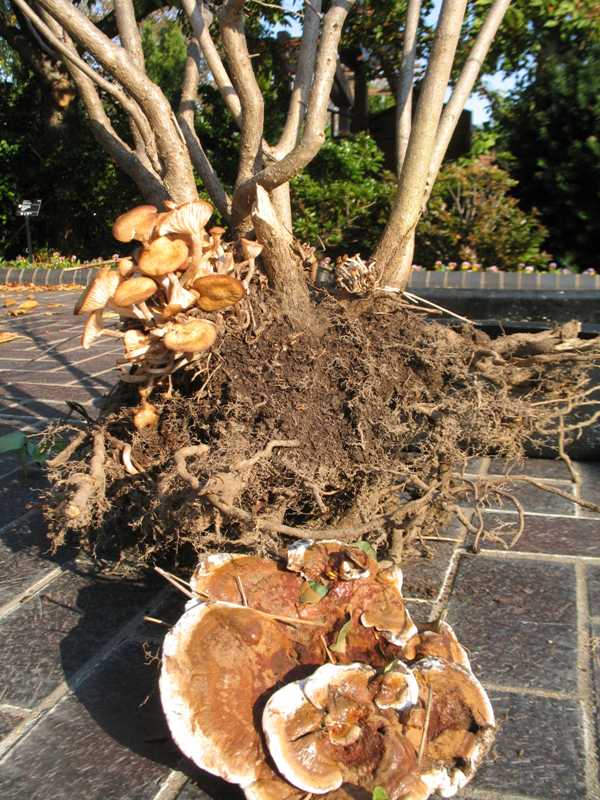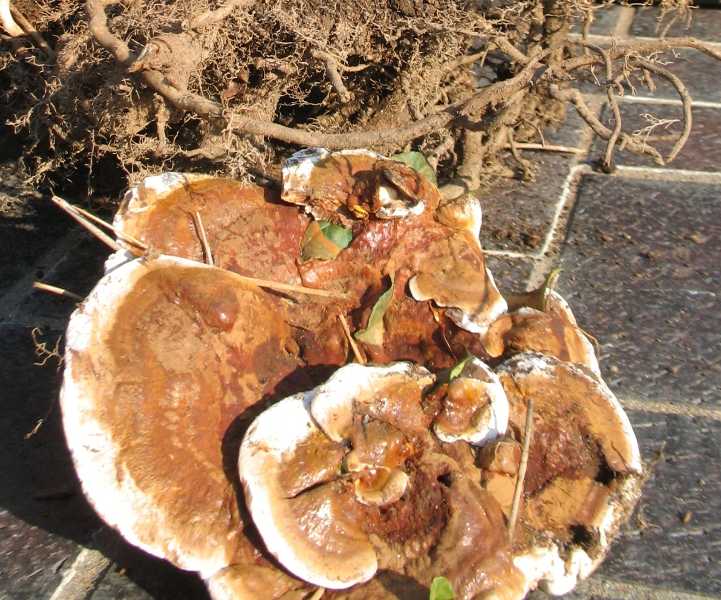To treat Ganoderma root rot, improve soil drainage and reduce moisture levels. Apply fungicides specifically designed for root rot to affected plants.
Ganoderma root rot is a serious fungal disease that affects various plants, particularly trees and shrubs. This pathogen thrives in damp conditions, leading to significant damage if not addressed quickly. Symptoms include wilting, yellowing leaves, and decaying roots. Early intervention is crucial to prevent extensive plant loss.
Effective treatment begins with identifying the disease and implementing proper cultural practices. Maintaining soil health and reducing excess moisture can help manage and prevent further outbreaks. Understanding this disease’s nature empowers gardeners and landscapers to take action, ensuring the longevity and health of their plants. Taking proactive steps can save your garden from this destructive fungus.

Credit: sesmastreeservice.com
How to Treat Ganoderma Root Rot : Step by Step Guide
Introduction To Ganoderma Root Rot
Ganoderma root rot is a serious fungal disease affecting many plants. Recognizing the signs early can save your plants. Look for yellowing leaves, wilting, and stunted growth. Dark, soft roots indicate trouble. Check for mushroom growth near the base of the plant.
The impact on plants can be devastating. Infected plants may struggle to absorb nutrients and water. This leads to poor health and eventual death. Healthy plants nearby can also be at risk. Preventing the spread of the fungus is crucial.
Maintaining proper soil drainage and avoiding overwatering helps prevent root rot. Regularly inspect your plants for any signs of disease. Prompt action can make a difference in plant health.
Early Detection Strategies
Monitoring plant health is key to spotting Ganoderma root rot. Look for yellowing leaves and stunted growth. These signs often indicate stress in plants. Check the roots for dark, mushy areas. This can be a clear sign of rot.
Using the right tools for diagnosis helps improve detection. A soil moisture meter shows if the soil is too wet. A pH meter can indicate unhealthy soil conditions. Regular inspections with these tools can prevent further damage.
| Tool | Purpose |
|---|---|
| Soil Moisture Meter | Detects overwatering |
| pH Meter | Checks soil acidity |
| Magnifying Glass | Examines roots closely |
Cultural Control Methods
Improving soil drainage is essential for controlling Ganoderma root rot. Start by using well-draining soil. Raised beds can help with excess water. Adding organic matter also enhances drainage.
Proper watering techniques play a crucial role. Water plants early in the morning. This allows the soil to dry during the day. Avoid overwatering, as it can suffocate roots. Use a moisture meter to check soil levels.
Consider using drip irrigation to deliver water directly to the roots. This method prevents water from pooling around the plant base. Always monitor weather conditions to adjust watering schedules.
Chemical Treatment Options
Choosing the right fungicide is crucial for treating Ganoderma root rot. Select a product that targets fungal diseases effectively. Look for active ingredients like propiconazole or tebuconazole. Always check the label for specific instructions.
Application best practices ensure better results. Apply fungicides during dry weather. Avoid spraying on windy days to prevent drift. Use a sprayer that provides even coverage. Follow the recommended dosage to avoid harming plants.
Consider the timing of applications. Early treatment is key when symptoms first appear. Reapply as needed based on product instructions. Monitor plants closely after treatment for signs of improvement.
Biological Control Innovations
Using beneficial microorganisms helps treat Ganoderma root rot effectively. These tiny helpers can fight harmful pathogens. They promote plant health and boost growth.
Integrating biocontrol agents into soil improves its quality. These agents include bacteria, fungi, and other microbes. They create a strong defense against diseases.
Some popular biocontrol agents are:
- Bacillus subtilis – protects roots from pathogens.
- Trichoderma spp. – suppresses harmful fungi.
- Pseudomonas fluorescens – enhances plant growth and resilience.
Using these microorganisms can lead to healthier plants. They can make a big difference in managing root rot.

Credit: www.missouribotanicalgarden.org
Plant Resistance And Selection
Choosing resistant varieties is key to managing Ganoderma root rot. Look for plants that show strong resistance to this disease. These varieties can help reduce crop losses significantly.
Genetic solutions play a crucial role in fighting this issue. Breeding programs focus on developing plants with natural resistance. This can enhance the overall health of the plants.
Some important traits to look for include:
- Strong root systems
- Thickened stems
- Faster growth rates
By selecting the right varieties, growers can ensure better plant health and yield. This approach leads to more sustainable farming practices.
Soil Health And Management
Healthy soil is key for fighting Ganoderma root rot. Enriching soil with organic matter boosts its health. Compost, manure, and cover crops can improve soil structure. These materials add nutrients and promote beneficial microorganisms.
Practicing crop rotation helps prevent the disease. Different crops can break the cycle of pathogens. It reduces the risk of Ganoderma spreading in the soil. Planting diverse crops also enhances soil biodiversity.
| Organic Matter Sources | Benefits |
|---|---|
| Compost | Improves soil fertility and structure. |
| Manure | Provides essential nutrients for crops. |
| Cover Crops | Prevents soil erosion and adds organic matter. |

Credit: oneilstreeservice.com
Recovery And Replanting Strategies
Post-treatment care is vital for healthy plants. Water the plants regularly but avoid overwatering. Use organic fertilizers to boost growth. Check for any signs of pests or disease frequently.
Future prevention plans should focus on soil health. Use well-draining soil to prevent root rot. Rotate crops to avoid recurring issues. Always remove dead plant material to keep the area clean. Consider using fungicides as a preventive measure.
Community And Expert Support
Connecting with the community can provide valuable insights. Local gardeners often have first-hand experience with Ganoderma root rot. Sharing tips and best practices can help everyone succeed.
Consulting with plant pathologists is another important step. These experts have in-depth knowledge of plant diseases. They can offer specific advice tailored to your situation. Early detection is key to managing Ganoderma root rot effectively.
Consider joining local gardening clubs or online forums. These platforms allow for sharing experiences and solutions. Engaging with experts and fellow gardeners can enhance your understanding.
Conclusion: A Holistic Approach
Treating Ganoderma root rot requires a holistic approach. Start by ensuring proper drainage in the soil. This helps prevent waterlogging, a key factor in root rot. Use sterilized tools to avoid spreading the disease. Regularly check plants for early signs of rot. Remove any infected parts immediately.
Healthy plants are more resistant to rot. Give your plants proper nutrition and light. Consider using beneficial fungi to improve soil health. This can create a better environment for roots.
Continued vigilance is essential. Regular monitoring of plants helps catch issues early. Treat any infections promptly to avoid further damage. Maintain a consistent care routine to support plant health.
Frequently Asked Questions
How Can I Identify Ganoderma Root Rot?
Ganoderma root rot is often identified by yellowing leaves and wilting plants. Look for dark, decayed roots and a distinct mushroom-like fungus at the base. Early detection is crucial for effective treatment. Regularly inspecting your plants can help you catch these signs before they worsen.
What Causes Ganoderma Root Rot?
Ganoderma root rot is primarily caused by the Ganoderma fungus. This pathogen thrives in overly moist soil and poor drainage conditions. It can infect healthy plants, leading to decline and death. Environmental stressors, such as drought or nutrient deficiencies, can also contribute to its onset.
How Can I Treat Ganoderma Root Rot?
To treat Ganoderma root rot, start by removing infected plants. Improve soil drainage to prevent future infections. You can apply fungicides specifically designed for root rot. Additionally, introducing beneficial microbes can help restore soil health and reduce fungal presence.
Can Ganoderma Root Rot Be Prevented?
Yes, Ganoderma root rot can be prevented. Ensure proper drainage in your garden to avoid standing water. Rotate crops regularly and maintain healthy soil conditions. Regularly inspect plants for early signs of infection, and act quickly if you notice any issues.
Conclusion
Treating Ganoderma root rot requires timely intervention and proper care. Implementing the right techniques can save your plants. Regular monitoring and maintaining healthy soil conditions are essential. By following these steps, you can effectively combat this issue. Stay proactive and ensure your garden thrives despite challenges like Ganoderma root rot.

